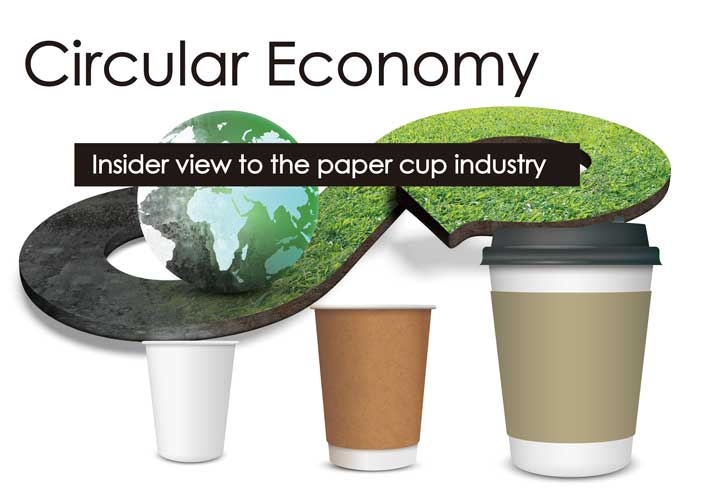Circular Economy: insider view to the paper cup industry

This article is a commentary on the paper cup industry in terms of its role in the circular economy. To provide a comprehensive discussion about the paper cup industry through four different topics. First, looking into the different ways to make the paper cup more environmentally friendly on the market. Then diving into the industry status quo on the efforts placed into making the paper cup more environmentally friendly and its effectiveness. Then jumping into the paper cup market potential in terms of government policies and regulations, market volume, and market value. Last, ending with my personal perspective on how the paper cup industry will play out in the circular economy.
The different ways to make the paper cup more environmentally friendly
There are many different ways to make the paper cup more environmentally friendly. This includes starting from the product, or by leveraging the recycling activities of these paper cups, and of course by not using the single-use paper cup in the first place.
Product
Most of the paper cups today are PE coated. The reason for the PE coating is to enhance the functionality of the paper cups to make them more leakage resistant and heat resistant so that the coffee that you hold in your hands won’t leak out or have you get burned. However, it is this PE coating that made paper cup recycling almost impossible from a cost perspective. The technology to recycle the PE coated cups is there, it's just that it is not cost-justified. That’s why according to BBC news, 99.75% of paper coffee cups are not recycled. Therefore, one way to solve this issue is to make the paper cup product more recyclable from the start by replacing the traditional PE coating with a water-based coating, pigment-based coating, bioplastics or to alter the paper fibers to increase its functionality so that no PE coating is needed. Another way to improve the eco-friendliness of the paper cup is to reduce the amount of PE coating used. To reduce the amount of plastic composition and to increase the amount of recycled paper used in paper cup production.
Recycling activities
To encourage the recycling activities of these paper cups. This not only includes the consumers dropping the cups into the recycling bins for paper cups but also ensuring the paper cups do end up reaching the recycling facilities. At the same time, the recycling facilities receiving the paper cups need to have the technology to extract the paper fiber for reuse. Most importantly, to provide the recycling facilities with enough incentive to perform these recycling activities. Besides extracting the paper fiber for reuse, facilities can also compost the paper cups if they are biodegradable.
Abandoning single-use paper cup
The most straightforward way is to not to use single-use paper cups at all. To instead look for alternative systems such as stores providing or consumers bringing their own reusable cups. Paper cup replacements such as thermos cups, glasses, and porcelain cups. However, for the reuse system to work, there needs to be a cleaning mechanism in place. The consumer either has to clean the cups on their own, or cleaning stations need to be step up in stores or throughout the community.
The effectiveness of the current paper cup recycling system
As mentioned above that there are technologies to recycle PE-coated paper cups. Furthermore, technology for the production of more easily recycled / biodegradable paper cups is also available. Unfortunately, the current progress towards the paper cup recycling system has been ineffective. So why is the current paper cup recycling system ineffective? Let’s look at this issue from a product perspective and from an ecosystem perspective
Ineffectiveness from a product perspective
The product can be 100% recyclable and biodegradable. The product can be 100% environmentally friendly. However, at the end of the day, it comes down to being cost-justified. Paper cup production companies are in the market for business, not for charity, and definitely not for the good of human society. They are here to make profits. This goes the same for the recycling facilities. From a product perspective, another issue is the stability of the supply chain. Besides PE coating on paper cups, there are currently no mainstream methods when it comes to producing a more environmentally friendly cup. Therefore, the supply chain for the raw materials going into producing a more environmentally friendly cup is less structured. As result, causing more fluctuation and uncertainties in the market supply.
Ineffectiveness from an ecosystem perspective
As mentioned above that there is currently no mainstream method to produce a more recyclable/biodegradable paper cup. This indicates that there is a lack of standardization when it comes to products, collection systems, and recycling systems. Product refers to the standardization of how production should be made. What is the standard on the composition of the paper cup? The product then will be associate with how the product should be collected and sorted. Is there a standardized system for the collection of paper cups? What recycling bins should be set up. Where the recycling bins should be set up. After collection, leading into the standardization of how the paper cup should be recycled or be composted. Will the recycling facilities accept paper cups? Do the recycling facilities have to capability to perform the recycling? Does it economically make sense to recycle?
The paper cup market potential
Government policies and regulations
As a PE-coated paper cup is considered more like a plastic product than a paper product. Let’s look into what is the current government policies and regulations associate with paper cups/plastics in different regions of the world?
- Taiwan – declared to become single usage plastic-free by 2030.
- European Union – declared to ban single usage plastic by 2023.
- USA (Berkeley) – Imposing a 25-cent tariff on single usage coffee paper cups starting 2020.
- Canada – banning many single usage plastics and containers in 2021.
- Australia – declared banning single usage plastics by 2023.
- New Zealand – declared banning single usage plastics by 2025.
- India – declared banning single usage plastics and coffee cups by 2022.
- Japan – To establish a recycling mechanism and to encourage consumers from using less single usage plastics.
- Korea – banning single usage coffee cups in 2021 and declared to reduce single usage plastics by 35% by 2022.
- Malaysia – Penang banned single usage plastics and the usage of plastics straws
- Indonesia – Banjarmasin, and Bandung banned plastic bags
- Thailand – to cut plastic bag usage by half in 2021
- Vietnam – charging for plastic bags
- Philippines – banning plastic bags usage in 27 cities.
Market volume
According to the CommonWealth Magazine, The global consumption of paper cups has reached 250 billion units per year. In Taiwan, the consumption of coated paper cups has reached 2 billion units per year, and the consumption for coated paper containers has reached 5 billion units per year. As for the consumption of OHH (out-of-home) paper-based coffee cups. According to North Carolina State University , the United States leads all nations in the consumption of OOH paper-based coffee cups: 136 million cups per day. This is followed by China (27.4 million), Russia (16.4 million), Germany (7.2 million), Britain (7.0 million), and Australia (2.7 million).
Market value
According to Grand View Research, the market for disposable cups is expected to reach USD 13.33 billion by 2021.
Perspective on how the paper cup industry will play out in the circular economy
In conclusion, there are many ways to achieve a more environmentally friendly paper cup system. From the current market, it looks like banning the single usage paper cup will become the dominant market solution.
The main obstacle towards producing a recyclable or compostable paper cup is not the technology, but instead, it is the standardization towards the product, collection system, and recycling system that needs to be built up. Is the ecosystem ready for a recyclable or compostable paper cup? At the same time is cost-justified. Deducing from the 2021 estimated global paper cup market value (USD 13.33 billion) and the estimated global paper cup volume (250 billion), the estimated value for a single paper cup is about USD 0.053 or 5.3 cents. If the cost of a newly developed recyclable or compostable paper cup can match the current paper cup value or less, then the market may lean towards the recyclable or compostable paper cup. Otherwise, from the currently given factors, banning the single usage paper cup and replacing it with reusable cups is likely to become the dominant market solution towards the circular economy.

Article by Daywey Chen, KYMC


























